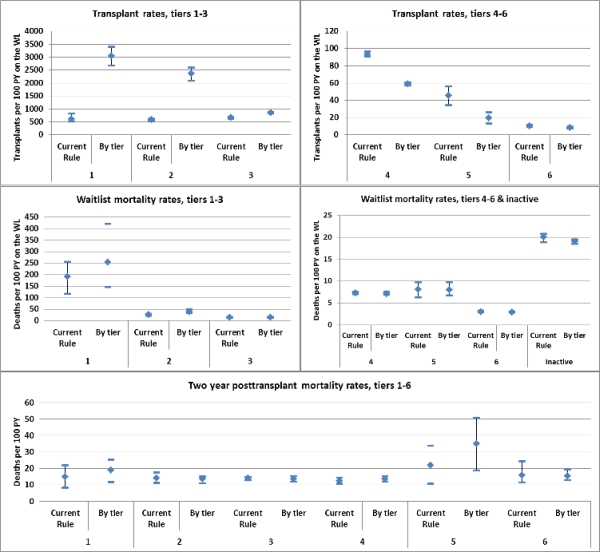Thoracic Simulation Allocation Modeling (TSAM) of a 6-Tier Allocation Strategy.
1SRTR, Minneapolis
2UNOS, Richmond
3Florida Hospital Transplant Inst, Orlando
4Nemours/AI duPont Hosp for Children, Wilmington
5Columbia Univ Medical Center, New York
6Duke Univ, Durham.
Meeting: 2016 American Transplant Congress
Abstract number: 4
Keywords: Allocation, Heart
Session Information
Session Time: 8:30am-9:45am
 Presentation Time: 9:15am-9:30am
Presentation Time: 9:15am-9:30am
Location: Veterans Auditorium
Heart allocation policy (OPTN policy 6) is in development. To stratify medical urgency, the Heart Subcommittee of the OPTN Thoracic Committee developed a 6-tier algorithm based on existing status criteria, diagnoses, and clinical factors identified through a review of exception narratives. We determined the impact of a 6-tier allocation system on waitlist and posttransplant outcomes using simulation.
Using TSAM software and OPTN data, we determined the relative impact of 6-tier urgency stratification on waitlist mortality rates, transplant rates, and 2-year posttransplant mortality. The study included 8885 heart and 141 heart-lung candidates listed for at least 1 day from July 1, 2009-June 30, 2011.
Overall, simulated allocation by tiers produced slightly lower transplant rates, lower waitlist mortality rates, and similar 2-year posttransplant mortality rates compared with simulated allocation under current rules. Allocation by tiers produced higher transplant rates in the most severely ill groups, tiers 1-3, without marked increases in waitlist or posttransplant mortality in other tiers (Figure). Transplant rates were almost 5 times higher for tier-1 candidates and 4 times higher for tier-2 candidates. The increase in transplant rates was less striking in tier-3 candidates and similar or lower in tier 4-6 candidates. Increased transplant rates in adults did not affect rates in children, and we found no systematic disparities in access to transplant by age, sex, ethnicity, or blood type.
In simulations, allocation under the 6-tier system increased transplant rates in the most critically ill patients (tiers 1-3) without negatively affecting waitlist mortality for the less urgent tiers. The reduction in the overall transplant rate was likely due to less urgent patients awaiting transplant longer and with lower waitlist mortality.

CITATION INFORMATION: Colvin M, Skeans M, Robbins Callahan L, Edwards L, Zeglin J, Silvestry S, Davies R, Farr M, Israni A, Rogers J. Thoracic Simulation Allocation Modeling (TSAM) of a 6-Tier Allocation Strategy. Am J Transplant. 2016;16 (suppl 3).
To cite this abstract in AMA style:
Colvin M, Skeans M, Callahan LRobbins, Edwards L, Zeglin J, Silvestry S, Davies R, Farr M, Israni A, Rogers J. Thoracic Simulation Allocation Modeling (TSAM) of a 6-Tier Allocation Strategy. [abstract]. Am J Transplant. 2016; 16 (suppl 3). https://atcmeetingabstracts.com/abstract/thoracic-simulation-allocation-modeling-tsam-of-a-6-tier-allocation-strategy/. Accessed December 30, 2025.« Back to 2016 American Transplant Congress
